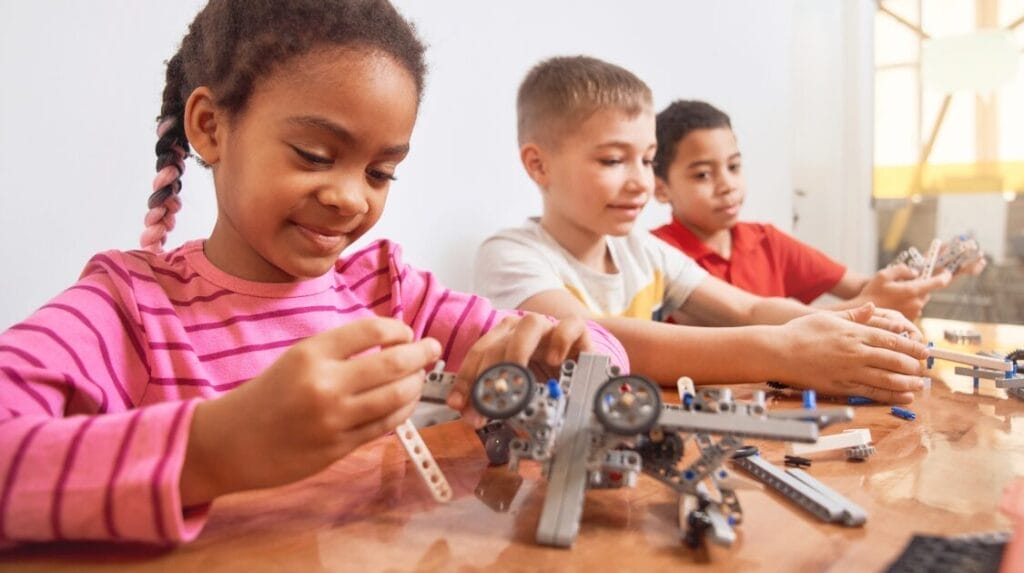
The Creativity Crisis
Every generation has fond memories of how much better it was when they were kids. Just 40 short years ago, children didn’t come home from playing until the street lights came on. They drank from the water hose, and an advertisement at 10:00 pm reminded parents to make sure their children were home. Kids played make-believe with friends in the sandbox, built forts, and creatively figured out how to not be bored, all while trying not to get into too much trouble.
Today’s youth are very different. Raised in a world of on-demand video, cell phones, and non-stop digital entertainment, kids have little opportunity to be bored. Without boredom, creativity is diminished. However, in today’s rapidly evolving world, creativity is no longer just a desirable skill; it is essential. Many educators and parents are increasingly concerned that children are not developing their creative potential either in school or during play. This deficiency can be attributed to an overly structured educational system and the pervasive influence of instant gratification culture.
Recent research indicates a worrying decline in children’s creativity. A study by Kyung Hee Kim found that while IQ scores have been rising, creativity scores have been decreasing since the 1990s. This phenomenon, known as the “creativity crisis,” can be partly attributed to the structured nature of modern education systems, which often prioritize standardized testing over creative exploration.
Children today spend less time in unstructured play, which is crucial for developing creativity. Instead, they are often engaged with digital devices that provide constant stimulation and limit opportunities for imaginative thinking. To address this issue, integrating design thinking into education can be a powerful solution.

Understanding Design Thinking
Design thinking is a problem-solving approach that involves empathizing with users, defining problems, ideating, prototyping, and testing. This process, originally developed for the design and business sectors, has been increasingly recognized for its potential in education. Encouraging students to think like designers fosters creativity, critical thinking, and collaboration.
How Design Thinking Can Help with the Creativity Crisis
- Fostering Empathy and Understanding: The first stage in design thinking is empathy. Children learn to understand the needs and perspectives of others, which enhances their emotional intelligence and creativity. By empathizing with end-users, they can develop more innovative and relative solutions to problems.
- Encouraging Problem Definition and Exploration: Design thinking teaches children to define problems clearly. This process involves exploring various aspects of a problem and asking critical questions. The define stage helps children develop a deeper understanding of issues and encourages them to think critically.
- Promoting Ideation and Brainstorming: In the ideation stage, children are encouraged to brainstorm multiple solutions without the fear of failure. This stage is vital for creativity as it allows children to explore a wide range of ideas and approaches without fear of criticism or reproach.
- Hands-On Prototyping and Experimentation: The prototyping stage involves creating tangible representations of ideas. This hands-on approach helps children learn by doing, which is essential for developing creative problem-solving skills. Experimentation and iteration are key components, teaching children that failure is part of the learning process.
- Iterative Testing and Feedback: Testing is the final stage in design thinking. This stage involves testing prototypes and gathering feedback from multiple stakeholders and potential end users. This iterative process helps children refine their ideas and learn from their mistakes, fostering resilience and adaptability.

Evidence of Effectiveness
Several studies highlight the benefits of design thinking in education. For instance, a 2010 study by Carroll et al. found that incorporating design thinking into the curriculum improved students’ engagement, collaboration, and problem-solving skills. Another study, this one by Henriksen et al., demonstrated that design thinking projects enhanced students’ creative confidence and ability to innovate.
Additionally, research by Rauth et al. showed that students who participated in design thinking workshops exhibited greater creativity and critical thinking abilities compared to those who did not participate. These findings underscore the potential of design thinking to reinvigorate creativity in children.
Practical Implementation
To effectively integrate design thinking into education, schools and educators can:
- Encourage Interdisciplinary Projects: Design thinking works best when applied to real-world problems that require knowledge from various disciplines. Interdisciplinary projects help students see the connections between different subjects and develop a more holistic understanding of issues.
- Provide Time for Unstructured Play: Allowing children time for unstructured play is crucial for fostering creativity. Schools can create maker spaces or innovation labs where students can experiment with materials and ideas without the confines of a traditional classroom setting.
- Train Teachers in Design Thinking: Educators need to be trained in design thinking principles and practices. Professional development programs can equip teachers with the skills and knowledge to effectively implement design thinking in their classrooms. Design thinking is not just for STEM or elective courses. It can be integrated into lessons in core content areas, and is a great tool for encouraging students to develop relevant and meaningful connections to content beyond test preparation.
- Incorporate Technology Mindfully: While technology can be a powerful tool for learning, it should be used with educated intentionality to enhance creativity. Educators should look for digital tools that support design thinking, such as 3D modeling software or collaborative platforms.
Creating a Culture of Creativity, Together
In a world where creative problem-solving is increasingly important, design thinking offers a valuable approach to reinvigorating children’s creative potential. By fostering empathy, critical thinking, and hands-on experimentation, design thinking can help address the creativity crisis in education. It encourages children to explore, innovate, and develop the skills needed to thrive in the 21st century. As educators and parents, it is our responsibility to provide opportunities for children to unleash their creativity and become the problem-solvers of tomorrow.
Learn more about design thinking with our training and development resources.
Also, read our previous blog on free STEM resources, including design thinking lessons.
And if you would like to learn more about resources and programs to integrate design thinking into your school, classroom or homeschool group, please contact us at [email protected].


